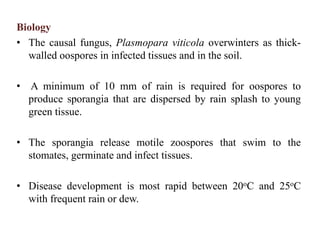Plant pathogen
- 1. Dr. Hanumantappa B Nayaka M.Sc., M.Phil., PhD., PDF(Spain)., MIScT (U K) Asst. Professor Department of Life Sciences Kristu Jayanti College Autonomous Bengaluru-77, Karnataka Plant Pathogens
- 2. Introduction • Diseases and pests represent a major threat to the commercial production of grapes in the world. • Climatic conditions are conducive to the development of several major grape diseases, including black rot, downy and powdery mildew. • Each of these diseases has the potential to destroy the entire crop. • Most diseases occur simultaneously within the same vineyard during the growing season.
- 3. Downy Mildew Causal organism Scientific Name: Plasmopara viticola Symptoms Leaves • Roughly circular yellowish discolourations called “oil spots”. • White fluffy growth primarily on the lower leaf surface. • As lesions age, they turn brown from the centre outward. • Severely infected leaves may drop. Small, circular lesions on upper side of leaf Downey mildew growth on under side of leaf
- 4. Shoots • Infected shoot tips curl and covered with white fluffy sporulation. Berries • White fluffy sporulation on small berries. • May shrivel and drop off. • Stay hard when healthy berries start to soften at veraison. Downey mildew growth on berries Severely infected berries Courtesy: www. Ohioline. osu. edu
- 5. Biology • The causal fungus, Plasmopara viticola overwinters as thick- walled oospores in infected tissues and in the soil. • A minimum of 10 mm of rain is required for oospores to produce sporangia that are dispersed by rain splash to young green tissue. • The sporangia release motile zoospores that swim to the stomates, germinate and infect tissues. • Disease development is most rapid between 20oC and 25oC with frequent rain or dew.
- 6. Powdery mildew Causal organism Scientific Name : Erysiphe necator (previously Uncinula necator) Losses in yield of fruits may be upto 40-60%. In addition to loss of yield, infected berries tend to be higher in acid content than healthy fruits and are unsuitable for wine making. Symptoms: On all tissues, powdery mildew looks like a greyish-white powder. Leaves • Frequently first found on the undersides of leaves. • Lesions become apparent on the upper sides of leaves as well. • On rapidly growing leaves, infections on the underside may cause the leaves to appear puckered on top.
- 7. • Severely infected leaves may become brittle and drop off. • Starting as early as late July, very small orange then brown and eventually black spherical structures cleistothecia develop on the upper and lower surfaces of infected leaves. Shoots • Initially greyish-white, develop into brown irregular blotches. • Indistinct margins and remain visible after shoot hardening. Berries • Become covered in conidia. • An initial floury appearance that later becomes dark and grey. • Dry out and may drop off. • Later infections (3-4 weeks post bloom) will have superficial greyish scarring.
- 8. Severe powdery mildew on berries Powdery mildew on upper side of leaves Severe powdery mildew on cane Powdery mildew on under side of leaves Courtesy: www.oardc.ohio/grapeipm
- 9. Black rot Causal organism Scientific Name: Guignardia bidwellii Symptoms Leaves • Relatively small, brown circular lesions develop on infected leaves and within a few days tiny black spherical fruiting bodies (pycnidia) protrude from them. Berries: • Infected berries first appear light or chocolate brown but quickly turn darker brown, with masses of black pycnidia developing on the surface. • Finally, infected berries shrivel and turn into hard black raisin-like bodies that are called mummies. Shoots • under high disease pressure brown to black elongated lesions develop.
- 10. Black rot lesions on leaves Mummified berries Infected berry with black pycnidia Black rot berries in cluster Tiny black pycnidia on leaf lesion Elongated lesions on petiole Courtesy: PHOTO BY R. PEARSON
- 11. Anthracnose/Birds eye disease Causal organism Scientific Name: Elsinoe ampelina • It is especially serious on new sprouts during rainy season. • Among various foliar diseases of grapevine in India, anthracnose has longest spell spread over the period from June to October Symptoms Leaves • Initially pin-prick dark spots. • Developing into small round spots with brown or black margins with greyish-white centres which drop out causing a ‘shot-hole’ appearance. • Severe infections cause malformed leaves that shrivel up and drop.
- 12. Shoots • Deep elongated cankers • Greyish in the centre with a raised dark reddish brown to violet-black edge • Infected shoots crack and become brittle Berries • Reddish circular spots becoming violet with a greyish centre and a raised black edge “bird’s eye rot” • Lesions can extend into the pulp, causing cracking and opening the berry to secondary infections • Severely infected berries dry up and drop prematurely.
- 13. Sunken lesions on shoots Anthracnose on berry Birds eye rot symptoms on berry Courtesy: www.oardc.ohio/grapeipm
- 14. Fusarium Wilt Causal organism Scientific Name: Fusarium oxysporum Symptoms: • Shoots and leaves wilt and die in mid-season, with characteristic brown-red discolouration of the vascular tissue of the affected areas. • Leaves drop prematurely and clusters fail to develop and shrivel to mummies. Symptoms range from one or two shoots on a vine to whole plant collapse.
- 15. Management • Collect and burn fallen leaves and twigs. • Sanitation of the orchard is highly essential. • Clean cultivation of vines or removal and destruction of all diseased parts. • Vine should be kept high above ground to allow circulation of air by proper Spacing • Grow resistant varieties like Chholth Red, Chholth white, Skibba Red (Powdery mildew), Amber Queen,Dogridge, Red Sultana (Downey mildew) and Banglore blue, Golden muscat, Golden queen (Anthracnose). • Prophylactic spray with B.M. 1% or Lime sulphur at dormant stage delays development of disease by decrease PM initial inoculum. • Spraying Bordeaux mixture 1% or COC@ 0.2% or carbendazim @0.1%.
- 16. Lets sum up ❖Downey mildew pathogen causes irregular, yellowish, translucent spots on the upper surface of the leaves and white fluffy sporulation on small berries. ❖On all tissues, powdery mildew looks like a greyish-white powder ❖Due to black rot, infected berries shrivel and turn into hard black raisin-like bodies that are called mummies. ❖Anthracnose affected berries shows ‘shot-hole’ appearance. ❖Pruning practices, trellis designs and vineyard lay outs that maximise air movement and light penetration within vine canopies discourage disease development. However, on susceptible varieties, fungicide spray programmes are required in most seasons to prevent crop loss.
- 17. Thank you

















